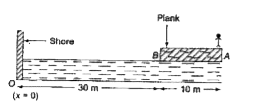A boy of mass m = 50 kg stands at the end A of a flat plank AB of wood of mass M = 100 kg and length l = 10 m floating in the still water in lake. The end B of the plank is at a distance of 30 m from the shore of the lake as shown in Fig. The boy walks a distance of 6 m on the plank towards the shore. If the boy is now at a distance 4(n−1)2m from the shore, the value of n is? (Neglect viscosity of water).

The correct Answer is:D
The centre of mass of the Plank boy system from the end B
x=100×5+50×10150=6.66m
When the boy walks through a distance 6 m, centre of mass will be at rest
∴50×6=(100+50)x
∴x=2m
The whole system move to right for a distance 2m.
∴ The distance of the boy from the shore = 40 - 6 + 2 = 36 m
36=4(n−1)2
(n−1)2=9
n - 1 = 3
n = 4
Similar Questions
A uniform wooden plank of mass 150 kg and length 8 m is floating on still water with a man of 50 kg at one end of it . The man walks to the other end of the plank and stops. Than the distance covered by the plank is
View SolutionA boy of mass 30 kg is standing at one end on a stationary boat over a lake. The boat has a mass 70 kg and length 10 m. Now the boy walked to the other end of the boat. Relative to the ground
View Solution
Knowledge Check
A uniform wooden plank of mass 150 kg and length 8 m is floating on still water with a man of 50 kg at one end of it . The man walks to the other end of the plank and stops. Than the distance covered by the plank is
A1 mB4 mC2 mDZeroA boy of mass m is standing at one end of a boat of mass M and length l. The boy walks to the other end, the displacement of the
ACM is zeroBboat is mlM+mCboy is mlM+mDboat is mMlA man of mass m stands at the left end of a uniform plank of length L and mass M, which lies on a frictionaless surface of ice. If the man walks to the other end of the plank, then by what distance does the plank slide on the ice?
ALBMLm+MCmLMDmLm+M
A boy of mass 30 kg is standing at one end on a stationary boat over a lake. The boat has a mass 70 kg and length 10 m. Now the boy walked to the other end of the boat. Relative to the ground
View SolutionA wooden log of mass 120kg is floating on still water perpendicular to the shore. A man of mass 80kg is standing at the centre of mass of the log and he is at a distance of 30m from the shore. When he walks through a distance of 10m towards the shore and halts, now his distance from the shore is
(A) 20m (B) 24m (C) 26m (D) 28m
View SolutionA boy of mass m stands on one end of a wooden plank of length L and mass M. The plank is floating on water. If the boy walks from one end of the plank to the other end at a constant speed, the resulting displacement of the plank is given by :
View SolutionA man of mass m stands at the left end of a uniform plank of length L and mass M, which lies on a frictionaless surface of ice. If the man walks to the other end of the plank, then by what distance does the plank slide on the ice?
View SolutionA man of mass m stands at the left end of a uniform plank of length L and mass M, which lies on a frictionaless surface of ice. If the man walks to the other end of the plank, then by what distance does the plank slide on the ice?
View Solution
